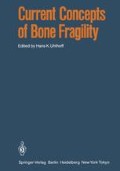Abstract
Age changes in bone mineral mass, volume and density in the human skeleton have been the subject of intensive investigation over the past 25 years. Changes with age in the histologic and mechanical properties of bone have also been studied by many investigators. The general picture emerging from these studies is a progressive net loss of bone mass with aging, beginning in the fifth decade and proceeding at a faster rate among women. Concurrent with this overall loss of bone is the change in bone material properties (Burstein et al, 1976), resulting in a bone tissue of reduced strength and modulus as described above. The major clinical consequence of these skeletal changes is an age-related increase in fracture incidence.
Access this chapter
Tax calculation will be finalised at checkout
Purchases are for personal use only
Preview
Unable to display preview. Download preview PDF.
References
Burstein, A.H., Reilly, D.T., and Martens, M.: Aging of bone tissue: Mechanical properties. J.Bone Joint Surg., 82, 1976.
Colbert, C., and Bachtell, R.S.: Radiographic absorptiometry (photo- densitometry). In, Non-invasive Measurements of Bone Mass and Their Clinical Application. Ed, Cohn, S.H., CRC Press, Boca Raton, 1981, pp 51–84.
Hayes, W.C.: Basic biomechanics of the skeleton. Proc. Current Concepts of Bone Fragility in Orthopaedics and Medicine, Springer-Verlag, 1985.
Mazess, R.B.: Noninvasive methods for quantitating trabecular bone. In, The Osteoporotic Syndrome: Detection, Prevention and Treatment. Ed, Avioli, L.V., Grune and Stratton, New York, 1983, pp 85–114.
Nagurka, M.L., and Hayes, W.C.: Technical note: An interactive graphics package for calculating cross-sectional properties of complex shapes. J.Biomech., 59, 1980.
Ruff, C.B., and Hayes, W.C.: Subperiosteal expansion and cortical remodeling of the human femur and tibia with aging. Science, 945, 1982.
Ruff, C.B., and Hayes, W.C.: Cross-sectional geometry of Pecos Pueblo femora and tibiae: A biomechanical investigation. II. Sex, age and site differences. Am.J.Phys.Anthrop., 383, 1983.
Ruff, C.BV and Hayes, W.C.: Bone mineral content in the lower limb: Relationship to cross-sectional geometry. J.Bone Joint Surg., 1024, 1984.
Editor information
Editors and Affiliations
Rights and permissions
Copyright information
© 1986 Springer-Verlag Berlin Heidelberg
About this paper
Cite this paper
Hayes, W.C., Ruff, C.B. (1986). Biomechanical Compensatory Mechanisms for Age-Related Changes in Cortical Bone. In: Uhthoff, H.K. (eds) Current Concepts of Bone Fragility. Springer, Berlin, Heidelberg. https://doi.org/10.1007/978-3-642-70709-4_32
Download citation
DOI: https://doi.org/10.1007/978-3-642-70709-4_32
Publisher Name: Springer, Berlin, Heidelberg
Print ISBN: 978-3-642-70711-7
Online ISBN: 978-3-642-70709-4
eBook Packages: Springer Book Archive

